

Click map to see detailed route


Click map to see detailed route

26 August Yerevan
Gaumarjos began from the air
Gaumarjos! This is the Georgian equivalent of cheers, salut and ganbei. I have expected to experience the renowned Georgian hospitality and elaborate wine greeting rituals only when I arrive in Tbilisi in one week's time. However, fate determined that I should share my London-to-Yerevan flight row with a Georgian lady and a Canadian doctor. Before long we were chatting like old friends and when the cabin crew served wine, I was given a preliminary introduction into the rites of "gaumarjos". The Canadian chap was going to spend 4 days in Tbilisi, on business. Too short, the Georgian lady declared, as you will spend two days drinking, 2 days recovering from the hangover, and you have no more days left for your work.
I arrived in Yerevan in the 30'C heat of a Caucasian summer. As the plane landed, Mt Ararat – legendary site of Noah's Ark and symbol of the Armenian nation (even though it lies within Turkey today) - greeted us with its snowcapped double peaks. Armenia, here I come.
"Go ahead, destroy Armenia. See if you can do it. Send them into the desert without food and water. Burn their homes and churches. Then see if they will not laugh, sing and pray again. For when two of them meet anywhere in the world, see if they will not create a New Armenia."
William Saroyan, renowned Armenian-American writer
Armenia - this is one of the oldest nations on Earth. Descendants of the mysterious Urartu Civilisation (contemporary of the Mesopotamians), historic Armenia once stretches across eastern Turkey into the Republic of Armenia today. It stood at the crossroads of the continents and have always been the testing ground of ideas and the stepping ground of foreign armies. Christianity came and in 301 A.D., Armenia became the first country in the world to accept Christianity as the state religion. Even today, the Armenian Apostolic Church stands strong with its own "pope", the Catholicos of Echmiadzin. The Romans, Persians, Byzantines, Russians and Ottomans have all conquered this land and somehow the Armenians survived. The worst blow of all came in 1915, when the Ottoman Turks massacred 1.5 million Armenians - more than half the nation. Survivors of the massacre escaped southwards into Syria and then moved on to the rest of the world (especially to Los Angeles area and France) – and some eastwards into the small bit of historic Armenia held by the Russians. The Armenian Genocide is the first of the great genocides of the 20th century. As Hitler commented before committing his crimes against the Jews, "Who remembers the Armenians today".
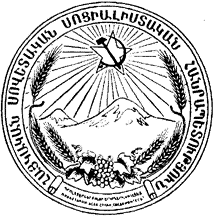 Arms
of the Armenia SSR When the Bolsheviks came, they declared
that tiny remaining strip of land the Armenian Soviet Socialist Republic
- and that forms what is today the Republic of Armenia. Armenian
entered world headlines again in 1988 with the great earthquake that killed
28,000 together with the destructive war against Azerbaijan. Armenians
in the tiny enclave of Nagorny Karabakh (Nagorno-Karabakh Republic or “NKR”),
surrounded by Azerbaijan proper, protested against alleged Azeri discrimination.
Anger soon turned into riots and armed conflict. Open warfare broke
out before and intensified after the downfall of the USSR in 1991, which
resulted in the independence of both Armenia and Azerbaijan. Despite
a harsh blockade on landlocked Armenia imposed by Azerbaijan and their
ethnic cousins in Turkey, the Armenians defeated the Azeris, with substantial
aid from Russia as well as Armenians worldwide, particularly those from
the USA.
Arms
of the Armenia SSR When the Bolsheviks came, they declared
that tiny remaining strip of land the Armenian Soviet Socialist Republic
- and that forms what is today the Republic of Armenia. Armenian
entered world headlines again in 1988 with the great earthquake that killed
28,000 together with the destructive war against Azerbaijan. Armenians
in the tiny enclave of Nagorny Karabakh (Nagorno-Karabakh Republic or “NKR”),
surrounded by Azerbaijan proper, protested against alleged Azeri discrimination.
Anger soon turned into riots and armed conflict. Open warfare broke
out before and intensified after the downfall of the USSR in 1991, which
resulted in the independence of both Armenia and Azerbaijan. Despite
a harsh blockade on landlocked Armenia imposed by Azerbaijan and their
ethnic cousins in Turkey, the Armenians defeated the Azeris, with substantial
aid from Russia as well as Armenians worldwide, particularly those from
the USA.
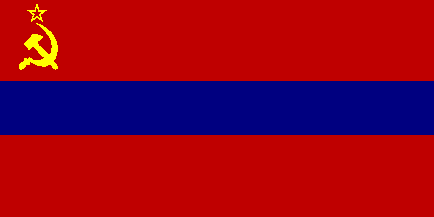 Flag of the Armenian SSR. However, an uneasy state of peace
remains and the poor economic outlook has led to emigration of half the
population abroad, mostly to Russia (amazing anyone wants to move there
given the state of Russian economy). The country continues to be
plagued by political instability. In October 1999, Prime Minister
Vazgen Sarkissian, who’s credited for the victory in Karabakh, Karen Demirchian,
speaker of Parliament and Soviet-era party chief, as well as a number of
prominent political figures were assassinated when gunmen seized the Parliament.
Flag of the Armenian SSR. However, an uneasy state of peace
remains and the poor economic outlook has led to emigration of half the
population abroad, mostly to Russia (amazing anyone wants to move there
given the state of Russian economy). The country continues to be
plagued by political instability. In October 1999, Prime Minister
Vazgen Sarkissian, who’s credited for the victory in Karabakh, Karen Demirchian,
speaker of Parliament and Soviet-era party chief, as well as a number of
prominent political figures were assassinated when gunmen seized the Parliament.
Nigol, an Armenian-Canadian born in Lebanon, and his driver, Ara, also
Lebanon-born, picked me up at the airport. Both Nigol and Ara were
descendants of the Genocide survivors. Both grew up in a Lebanon
torn apart by ethnic/religious conflicts, and decided that the real homeland
is Armenia. Both came during the time of the Karabakh War to assist in
the civilian war effort. During this trip, I was to meet many Diaspora
Armenians and continuously amazed by their affinity to this land, despite
being 2nd, 3rd or 4th generation French, Americans and what-have-you. Some
Diaspora Armenians even returned to fight in the Karabakh war and lost
their lives for an ancestral homeland which they visited for the first
time only now. Most notable among them was Monte Melkonian, a commander
born in Fresno, California, rumoured to be Cher’s second cousin. This is
something that, I, as a Singaporean of Chinese ethnic origin, find difficult
to understand, for most Chinese outside China tend to regard themselves
as Singaporeans, Malaysians, Americans, Thais, etc, although all are proud
of their Chinese cultural heritage. Perhaps, like an Armenian-French
later explained to me, “There are more than 1 billion Chinese.and there
are so few Armenians. If we Armenians don’t preserve our culture,
it will disappear forever.”
Yerevan: Ancient Alphabet and Assyrian Look-A-Like
From Zvartnost Airport, I was driven to an apartment in Komitas, in the northern part of Yerevan. That will be place I will spend my Armenian nights. Located in the fertile plains of the Ararat, Yerevan, capital of Armenia, is a rather dusty and dry place. The Yerevan of today is a rather new city, although its foundations dated from Urartu days several thousand years ago. When it was declared capital of Soviet Armenia, it was but a small provincial town with one and two storey buildings. The Soviet state went on to rebuild a whole new city worthy of the capital of a Soviet Socialist Republic, with huge complexes and grand monuments many of which were decorated with motifs and symbols that reminded one of the grandeur of the Uratu/Mesopotamian civilizations. However, the fact that many of the buildings are huge, squarish blocks, and were built from volcanic tufa and basalt stone, unfortunately, gave the city a somewhat cold, lifeless feel, although my experiences with the people here was to be anything but boring. I was to enjoy myself here, thanks to my Armenian friends.
After dumping my stuff at the apartment, we proceeded to the Permanent Mission of the Nagorno Karabakh Republic where I obtained my NKR visa. I would set off for NKR the following day. The visa cost US$25 and some friends have told me it wasn’t necessary, as there would be no checkpoints. Indeed no one would check my passport at all in NKR. However, as I obviously look anything but Armenian or Caucasian, the risk of me being examined by police was fairly high – and indeed I have been stopped by every tom, dick and harry uniformed personnel everyday whenever I travelled in the ex-USSR. I’d better be safe than sorry, although the appeal of being detained a few days thus providing good story material does appeal to a certain extent. Of course, my London banking bosses wouldn’t have tolerated an excuse for returning to work late because “I was detained by police”… While speaking to the consul, Nigol mentioned about my website, and that prompted the question, “Is he a journalist ?” “No, no…” Nobody likes journalists and she probably has this running across her mind – “what nasty things they can write about our often misunderstood republic…” What meant as a compliment could have denied me the permission to visit NKR.
After the visa was obtained, despite a tiring overnight flight, I began my exploration of the city. Very dusty and dry, Yerevan was located in a valley that trapped heat and despite being tropical in origin, I was worn out by heat in no time. Yes, the Ararat does rise high above the city, but it’s plainly the wrong season to capture that ever-enticing image of the snowcapped peak overlooking the metropolis… Summer skies here are typically covered in mist and dust, and one can barely make out the mount beyond a faint silhouette.
I went to the Matenadaren, the depository of ancient Armenian manuscripts. I have long heard of this place and was mildly disappointed that only a small selection was in display. In any case, the museum building itself was grand and the statue of St Mesrops Mashtots guarded its entrance – the saint was the inventor of the 38-letter Armenian alphabet (36 were invented by him and 2 added later by others). Invented in 406 AD, the alphabet is regarded by Armenians as the proof of their national uniqueness and the symbol of their survival in a harsh world. The moment Soviet rule fell, the Armenians promptly dumped the Russian language and embraced their national tongue with great enthusiasm. Old Russian signs are no longer renewed when they rusted away. Instead Armenian signs were used, although few apart from the Armenians knew their ancient alphabet. This does meant difficulty for the foreign tourist, especially when one is in the metro. I had to count the number of stops to get off at the right station, and from time to time, panicked a little when I lost count of the number of stops as a result of conversations with other commuters.
Yes, speaking of the metro – I was told that during the Soviet days, rules were that only cities with population more than a million were allowed to have their underground network, and Yerevan proper did not satisfy that criteria. And so, the zealous bureaucrats of Armenia set about defining the boundaries of Yerevan, even including the sprawling countryside within city limits, thus meeting the criteria. Whatever it was, the population of Yerevan has somewhat declined since independence. The war in Karabakh together with the economic decline of the Republic, has led to an exodus out of the country, to Russia. Many said more than 50% of the population has left. I used to have an Armenian penpal in the early 1990’s and even she disappeared into thin air after her last letter mentioned about emigration to Russia. If Yerevan’s population has declined, the countryside has probably emptied itself, with the young jobless moving to Yerevan. What does this mean to the future of the Armenian nation ? Only time can tell.
The National History Museum at Republic Square was next. Nice
museum but a pity all captions were in Armenian. The mitigrant is
that one could get an English speaking guide for AMD 200, or less than
US$0.50. Unfortunately, I was really tired by then and kept yawning
no-stopped. The nice guide must have thought she bored me,
although this wasn’t the case. To the northwest of the Republic Square
was a green patch where an open air souvenir market kept me busy for the
next hour or so. My atrocious shopping-mad Singaporean mentality
came into play and I had to try hard to avoid burdening myself with stuff
on the very first day of this trip.
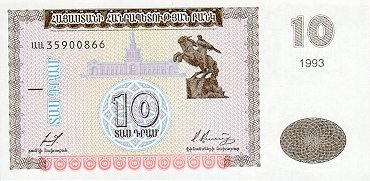 |
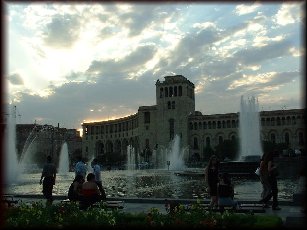 |
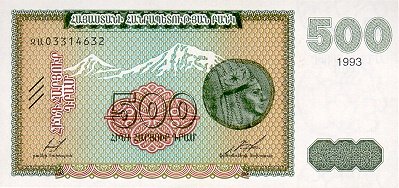 |
|
|
I took a taxi (US$5 to and fro including waiting time) to Erbuni Museum located on an ancient fortress mound in the suburbs of Yerevan. Erbuni, forerunner of Yerevan, was an Urartian fortress. First mentioned in Assyrian texts in the early 13th century BC as well as in the Bible, the Urartians are seen by the Armenians as their ancestors, although archaeologists are not entirely certain about that. In reality, it is probably right to say that no such thing as a pure race exists, and nations have been formed through intermarriages and cultural exchanges. And politicians and over-zealous historians often find it convenient to declare to others the ancient origins of their nation and thus more justifiable than that of other competing claims. Of course, Turkey also claim Urartians as their own, but this is somewhat even more remote, as the Turks came much later to the region – although many Turks probably have remnants of the Urartian DNA, given the great mix of populations in history. Whatever it is, Assyrian influence on Urartu is obvious, from the carvings, frescoes and art. The Assyrians had always considered Urartians a dangerous rival and both strived to destroy each other. Eventually, the Urartians were decimated when nomadic tribes came through the Caucasian passes in the north and wiped the Urartian cities off the map. The depopulated land was soon replaced by the Armenians, who probably absorbed the remaining Urartian tribes. Anyway, despite the lovely modern-day Mesopotamian-like sculptures, I must confess a slight disappointment with how small the museum was, although those with a somewhat more imaginative spirit would probably be able to experience the timelessness of the location while standing on the ancient excavations overlooking the museum building and the city. (I was told that funding dried up with independence). Frankly, I was more preoccupied with the embarrassment arising from a loud exchange of words between my taxi driver and the museum’s rear guards, for driving up the mounds for me to have a better view of the place – not something I had asked for.
Returning to Yerevan central, I met Raffi Kojian, a young Californian
of Armenian (born in Ethiopia!!!) origins. We have known each
other for 5 years or so via the internet and he runs a fantastic
website about Armenia. It’s nice meeting someone one has known for
a while and not for the first time, I must said how amazing the internet
is – bringing people worldwide together.
![]() 27 August Stepanakert (Nagorno Karabakh):
27 August Stepanakert (Nagorno Karabakh):
Journey To a Rebel Republic